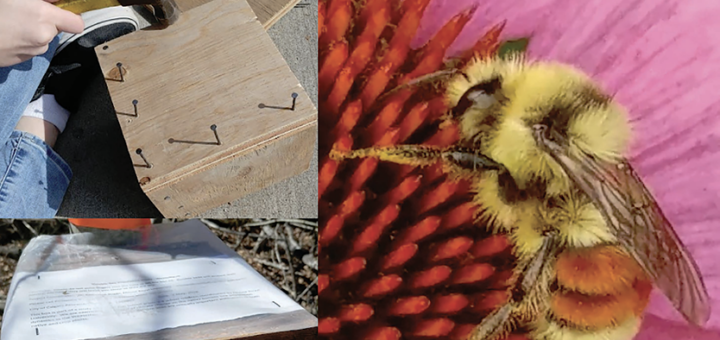Geography and bumblebees: A $120,000 project

By Liam Rockliffe, Contributor
With the help of bees, a Mount Royal University (MRU) professor is changing the way elementary students and educators learn about climate change.
Katherine Boggs, a geology expert and professor at MRU, spearheads the Community Science Liaison Program (CSLP) out of MRU. Starting in the naval reserves, and then going to school, Boggs realized her lifelong passion for geology. Coming to Calgary to be closer to the mountains, a job opened up at Mount Royal, and Boggs began sharing her passion with students.
Community Science Liaison Program
Through the Scholarship of Teaching and Learning, and later on Geoscience Education and Outreach, the CSLP was born. This project, led by Boggs, reaches into communities and provides them with opportunities to participate in science and provide learning opportunities otherwise unavailable. Kindergarten to grade 12 schools have the opportunity to work side by side with scientists and have the curriculum altered to include this student-sourced research.
“With the [CSLP], overall what it’s intended to do is to create the capacity for curriculum-based science projects parallel to scientists’ own projects,” said Boggs.
“It’s about promoting science into classrooms, supporting teachers who may not have a science background, and it’s about community building and creating connections between the outside world and universities.”
With two focuses currently in the CSLP—Resistance to Vaccine Misinformation and the Geological Bumblebee Program (GBB), Boggs and her team are hoping to expand the program with the help of the $120,000 grant.
Geographical bumblebee
How do geography and bumblebees come together to provide a valuable experience for children?
Young students learn about the life cycles of insects and study rocks and minerals. Combining these courses into one scientific experience gives children the hands-on experience they need to not fear science as they grow.
In Calgary, the glacier till — rocks brought and dropped by receding glaciers— is very interesting as ice sheets from the west and east meet in the south of our city, and no one knows yet the exact line of where they met. The geological component of the GBB program involves the kids taking measurements of the rocks and relaying their findings, then discovering the year that the rocks were formed. The activity blows the kids away. At this stage in the children’s learning, they have just begun to understand numbers, and a number such as 500 million years is completely mind-blowing— and yet only a little bit older than mom and dad.
For the bees, the kids build and install bumblebee boxes in the spring, and then collect the boxes in the fall. When the little scientists collect the boxes, the juvenile queen has left the colony to hibernate for the winter, and the rest of the colony dies off, completing the life cycle of bees. Meaning, there is no danger of the kids being stung.
Almost like Christmas morning, the kids get to open their boxes and see what is contained within. Boggs hopes to have the boxes linked to GPS on a website so the kids can follow the journey of their boxes years down the line. So far the GBB has had around 800 kids who have produced about 400 bee boxes.
A second-grade student says, “When researching, we found that bees are disappearing around the world and that scientists don’t know why. We want to help with the research.” The data produced by the kids’ bee boxes has helped scientists figure out which bees are endangered, as well as why and how they are disappearing.
Expanding the program
Boggs will be expanding the program to B.C., Yukon, and N.W.T. until it is firmly established in Western Canada. She plans to do this over the next three years, while also expanding the number of modules available.
The grant will largely be going towards extending the reach of the program and improving the quality and quantity of modules. Some other points that the funding will be going towards are hiring a full-time project manager, trips to expand the program, and building up the base so the program has room to grow.
Future projects include earthquake monitoring, GPS data, monitoring weather conditions, and studying the planet Venus.
Boggs is also hoping to get the 2028 International Geoscience Congress (IGC) to Calgary. Canada will present its bid in 2024 at the South Korean IGC conference.
This approach of including children in citizen science has been proven in Whitehorse, Yukon, to improve the reception of science, technology, engineering and mathematics (STEM) and increase graduation rates. In Whitehorse, the school took three groups of kids – above average, underperforming, and at-risk kids. Every kid graduates and around 60 per cent pursue STEM disciplines. There’s no other program with that kind of success rate.
The CSLP intends to bring this citizen science approach to Canadians and younger grades, providing scientific expertise from scientist participation. Having scientists travel to smaller communities, share their research, and include the children and community in their research and findings.



